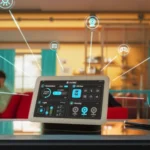Setting up a smart home doesn’t have to be expensive. With the right approach, you can integrate advanced technology into your living space without overspending.
From smart speakers and plugs to security cameras and thermostats, cost-effective options are available to make your home more efficient, secure, and convenient.
In this guide, you’ll learn how to assess your needs, choose affordable devices, and set up a seamless system that delivers high-tech functionality without breaking the bank.
Whether you’re new to smart home automation or looking to expand on a budget, these practical steps will help you create a customized solution tailored to your lifestyle. Let’s get started on building your budget-friendly smart home.
Assessing Your Needs and Setting a Budget
Before diving into the world of smart home technology, it’s essential to evaluate your specific needs and establish a realistic budget. Consider the following steps:
- Identify Your Priorities: Determine which aspects of your home would benefit most from automation. Common areas include lighting, security, climate control, and entertainment systems.
- Set a Budget: Decide on an amount you’re comfortable spending. Remember, you can start small and expand your system over time as your budget allows.
- Research Compatibility: Ensure that the devices you’re interested in are compatible with each other and can be controlled through a central platform or app.
ALSO READ: How to Create a Budget That You’ll Actually Stick to?
Affordable Smart Home Devices

Here are some budget-friendly devices to consider for your smart home setup:
Smart Speakers and Hubs
A smart speaker or hub serves as the command center for your smart home, allowing you to control various devices using voice commands or a dedicated app.
- Amazon Echo Dot (5th Generation): Priced around $23 during sales, this device offers Alexa integration, allowing control of compatible smart devices, music streaming, and more.
- Google Nest Mini: Typically, available for under $50, the Nest Mini provides Google Assistant capabilities, enabling voice control for a variety of smart home devices.
Smart Plugs
Smart plugs are an affordable way to add intelligence to your existing appliances, allowing you to control them remotely and set schedules.
- Kasa Smart Plug by TP-Link: A two-pack is often available for around $20. These plugs work with both Amazon Alexa and Google Assistant, enabling voice control and scheduling.
- Amazon Smart Plug: Priced around $13 during discounts, this plug integrates seamlessly with Alexa for easy voice control.
Smart Lighting
Upgrading to smart lighting enhances convenience and can contribute to energy savings.
- Sengled Smart LED Bulbs: These bulbs are often priced under $10 each and can be controlled via a mobile app or voice commands when paired with a compatible hub.
- Wyze Bulb: At approximately $8 per bulb, Wyze offers affordable smart lighting solutions that connect directly to your Wi-Fi network.
Smart Security Cameras
Enhancing your home’s security doesn’t have to be expensive.
- Wyze Cam v3: Priced around $36, this camera offers 1080p HD video, night vision, and two-way audio.
- Blink Video Doorbell and Sync Module 2: Often discounted to $34.99, this bundle provides a video doorbell solution with easy installation and Alexa integration.
Smart Thermostats
Smart thermostats can help you manage your home’s temperature more efficiently, leading to potential energy savings.
- Google Nest Thermostat: Available for around $85 during sales, this device allows you to control your home’s temperature remotely and learn your preferences over time.
ALSO READ: How to Write a Business Plan That Sets You Up for Success?
Setting Up Your Smart Home System

Once you’ve selected your devices, follow these steps to set up your smart home system:
- Centralize Control: Choose a central hub or smart assistant to manage your devices. Popular options include Amazon Echo, Google Nest Hub, and Apple HomePod.
- Install Devices: Follow the manufacturer’s instructions to install each device. Ensure they are connected to your Wi-Fi network and properly configured.
- Create Routines and Schedules: Use the associated apps to set up routines and schedules that enhance convenience and efficiency. For example, you can schedule lights to turn off automatically during daylight hours.
- Ensure Compatibility: Verify that all devices are compatible with your chosen hub or assistant to ensure seamless integration.
Maximizing Energy Efficiency
Implementing smart home devices can lead to significant energy savings. Consider the following tips:
- Smart Thermostats: Program your thermostat to adjust temperatures based on your daily routine, reducing energy consumption when you’re away.
- Smart Lighting: Set schedules for your lights to turn off during daylight hours or when rooms are unoccupied.
- Energy Monitoring: Use smart plugs with energy monitoring features to track and manage the energy usage of connected devices.
Enhancing Home Security on a Budget
Affordable smart security devices can provide peace of mind without a hefty price tag.
- Smart Cameras: Install cameras like the Wyze Cam v3 to monitor key areas of your home.
- Smart Doorbells: Devices like the Blink Video Doorbell allow you to see and communicate with visitors remotely.
Troubleshooting Common Issues
As you set up your smart home, you may encounter some common challenges:
- Connectivity Issues: Ensure your Wi-Fi network is stable and that devices are within range.
- Compatibility Problems: Verify that all devices are compatible with your central hub or each other.
- Installation Errors: Carefully follow the manufacturer’s installation guides to avoid errors.
- Software Glitches: Regularly check for firmware updates for your devices to resolve potential issues.
ALSO READ: How to Create a Minimalist Lifestyle for Greater Happiness?
Future-Proofing Your Smart Home

To ensure your smart home remains current and capable of integrating new technologies:
- Choose Scalable Systems: Opt for hubs and platforms known for extensive compatibility, allowing you to add new devices easily.
- Focus on Standardized Protocols: Select devices that use standard communication protocols like Zigbee, Z-Wave, or Matter to enhance interoperability.







